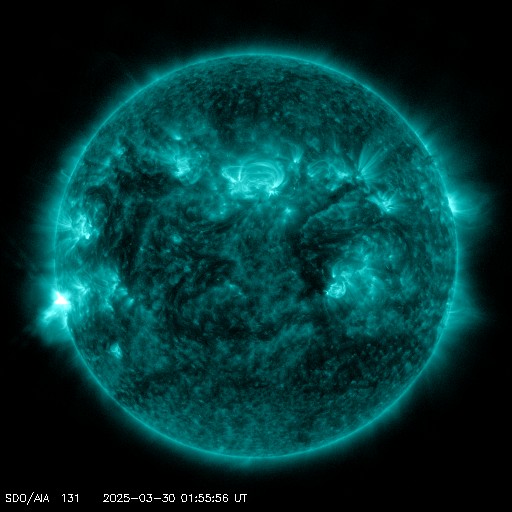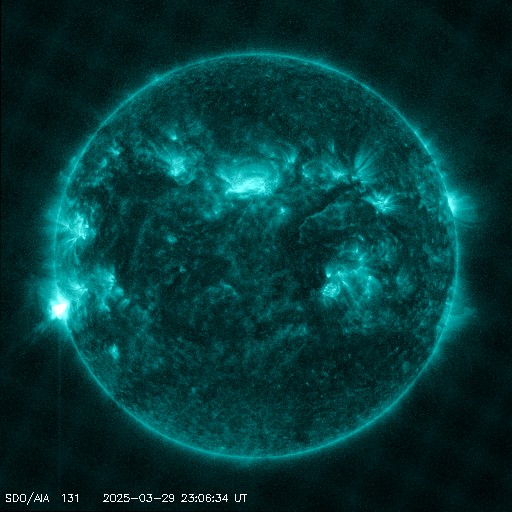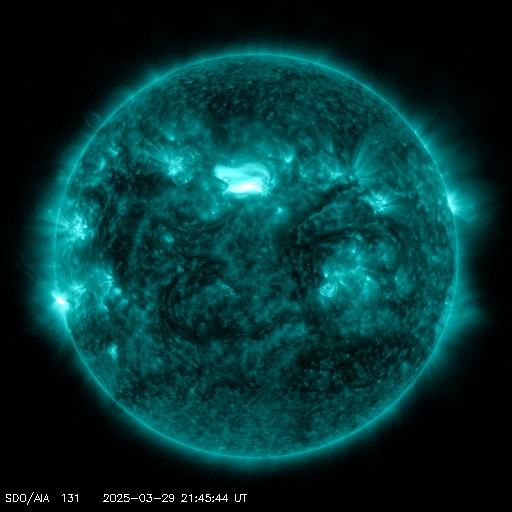Viewing archive of Thursday, 11 March 2010
Solar activity report
Any mentioned solar flare in this report has a scaling factor applied by the Space Weather Prediction Center (SWPC). Because of the SWPC scaling factor, solar flares are reported as 42% smaller than for the science quality data. The scaling factor has been removed from our archived solar flare data to reflect the true physical units.
Report of Solar-Geophysical Activity 2010 Mar 11 2201 UTCPrepared by the NOAA © SWPC and processed by SpaceWeatherLive.com
Joint USAF/NOAA Report of Solar and Geophysical Activity
SDF Number 070 Issued at 2200Z on 11 Mar 2010IA. Analysis of Solar Active Regions and Activity from 10-2100Z to 11-2100Z
Solar activity was very low. Todays activity consisted
of a few, low-level B-class events. The largest of these was a B4/Sf
at 2039Z from Region 1054 (N15E43). This region showed steady growth
throughout the day and is classified as a D type group. The total
sunspot area increased to about 160 millionths near the end of the
period. New Region 1055 (S23W15) also continued to emerge slowly and
is currently a C-type group with about 30 millionths in area.
IB. Solar Activity Forecast
Solar activity is expected to be very
low to low. There is a chance for an isolated C-class flare from
Region 1054 or 1055.
IIA. Geophysical Activity Summary 10-2100Z to 11-2100Z
The geomagnetic field was quiet to unsettled at mid latitudes and was
mostly unsettled to active at high latitudes. However, there were
some isolated storm intervals at high latitudes between 0000-1200Z.
Solar wind observations from ACE showed elevated velocities around
460-500 km/s with low density (1-3 p/cc). The signatures are
consistent with a weak high speed stream, presumably from the
southward extension of the northern polar coronal hole.
IIB. Geophysical Activity Forecast
The geomagnetic field is
expected to be quiet for the next two days (12-13 March). An
increase to quiet to unsettled is possible on the third day (14
March) due to effects from a recurrent solar sector boundary.
III. Event Probabilities 12 Mar to 14 Mar
| Class M | 05% | 05% | 05% |
| Class X | 01% | 01% | 01% |
| Proton | 01% | 01% | 01% |
| PCAF | green | ||
IV. Penticton 10.7 cm Flux
Observed 11 Mar 084 Predicted 12 Mar-14 Mar 085/085/085 90 Day Mean 11 Mar 082
V. Geomagnetic A Indices
Observed Afr/Ap 10 Mar 006/007 Estimated Afr/Ap 11 Mar 008/008 Predicted Afr/Ap 12 Mar-14 Mar 005/005-005/005-007/007
VI. Geomagnetic Activity Probabilities 12 Mar to 14 Mar
| A. Middle Latitudes | |||
|---|---|---|---|
| Active | 05% | 10% | 25% |
| Minor storm | 01% | 01% | 05% |
| Major-severe storm | 01% | 01% | 01% |
| B. High Latitudes | |||
|---|---|---|---|
| Active | 05% | 10% | 30% |
| Minor storm | 01% | 05% | 15% |
| Major-severe storm | 01% | 01% | 05% |
All times in UTC
Current data suggests there is a slight possibility for aurora to appear at the following high latitude regions in the near future
Gillam, MB, Whitehorse, YT, Yellowknife, NTFairbanks, AK
Latest news
Latest forum messages
AR4046 129AR4048 20AR4043 47Incoming & Unnumbered Active Regions 1658Aurora photography hints for those of us with smartphones 51
More topicsSupport SpaceWeatherLive.com!
A lot of people come to SpaceWeatherLive to follow the Sun's activity or if there is aurora to be seen, but with more traffic comes higher server costs. Consider a donation if you enjoy SpaceWeatherLive so we can keep the website online!

Latest alerts
02:09 UTC - Solar flare
Moderate M1.54 flare from sunspot region 4048
01:42 UTC - Radio Blackout
Minor R1 radio blackout in progress (≥M1 - current: M1.24)
Saturday, 29 March 2025
23:21 UTC - Solar flare
Moderate M1.91 flare from sunspot region 4048
22:51 UTC - Radio Blackout
Minor R1 radio blackout in progress (≥M1 - current: M1.1)
21:57 UTC - Solar flare
Moderate M1.45 flare from sunspot region 4048
Space weather facts
| Last X-flare | 2025/03/28 | X1.1 |
| Last M-flare | 2025/03/30 | M1.5 |
| Last geomagnetic storm | 2025/03/27 | Kp5 (G1) |
| Spotless days | |
|---|---|
| Last spotless day | 2022/06/08 |
| Monthly mean Sunspot Number | |
|---|---|
| February 2025 | 154.6 +17.6 |
| March 2025 | 127.5 -27.1 |
| Last 30 days | 127.5 -24.7 |





